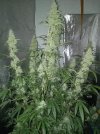cdgmoney250
Well-Known Member
I think both yes and no on the wide spectrum. If this was true then all outdoor weed would be superior to indoors and fetch a higher market price which is not quite true.
I’m going to have to disagree with you on the wide sun-like spectrum. Filling the cyan/green gap that is lacking from most traditional LED spectrums, is something that I’m working on right now and plant response is great so far. But when I was referring to broadening both ends of the spectrum, I was referring to blue/violet/UV nanometers and also deep red/Far Red nanometers. Like 365nm- 437nm & 660nm - 730nm, that are typically missing or minimally present in most standard LED spectrums.
I should also clarify when I’m talking about quality of plants grown under sunlight vs artificial light, I’m personally referring to indoor vs greenhouse grown, not just “outdoor” grown. Which don’t get me wrong, I’ve had excellent outdoor and excellent indoor herb. Outdoor grown is at the mercy of Mother Nature though. So if you don’t live in an ideal climate/environment, your end quality is likely to suffer some.
But, consistently the very best I’ve ever had has always come from soil grown greenhouse weed grown under the Sun, and it’s not even a close competition. The terpenes are so much more diverse and pronounced, the flavor seems to almost always translate through the smoke, and the high seems to last hours longer than indoor herb.
I’ve even seen cuts that myself and buddies ran for years indoors under different types of lighting look, smell, taste and feel very different and better in every way when grown in living soil in a greenhouse, under sunlight. It was unrecognizable and amazing (707 Headband). I’ve seen it personally a number times, and studies support what I’ve personally experienced.
Market pricing has nothing to do with how good the weed actually is unfortunately, at least in the States. Pricing is based on bag appeal, test #’s and the hype of the strain and that’s literally it. Not the nose or the taste or the quality of the smoke differentiates pricing. Here in the US, weed is legal to some degree in a majority of the populated states, but we are flooded with so much boof herb that I can’t take $1000 around town hitting up dispensaries or dealers and find good weed. There almost is no good weed on the market, just check the forums and see what older heads think. The market will buy what’s being provided, and currently that is mostly boof, but it’s priced as if it were actually good. I guess a majority of consumers may not actually know the difference between meh bud and outstanding bud.
Regarding your lighting tests, it would be cool to see the broad red from the last spectrum mixed with the double blue peak from the first spectrum. I’m hoping to be doing something similar in the next few months, but utilizing a number of different strips. Please keep us posted as you go!





